Kpop Demon Hunters: A Girl's Girl Movie
Movie Premise, Review, and Analysis
Introduction
Look, I’ve been through my magical-girl-saves-the-world-and-finds-confidence-in-herself-and-her-friends era. The Powerpuff Girls, Sailor Moon, Winx Club, and Barbie movies were my bread and butter growing up. I could not get enough of love and friendship and magic! Add in a love interest, and I’m hooked.
So when I heard of KPop Demon Hunters, my magical girl senses immediately sparked. The name of the movie sounded a little silly, but the art style intrigued me, and I wanted to know more. Plus, I’ve also been through my kdrama/pop phase, and even vacationed in Seoul for a week. That makes me an expert, right? (news flash: I am not, I am just a pro rambler on things I know little about.)
Premise
Rumi, Zoey, and Mira are part of an ancient line of protectors of their realm. With their voices, they maintain the Honmoon, a spiritual barrier that protects the human world from the demon world. For centuries, these protectors’ songs have stirred the hearts of humans and maintained the barrier, and once the barrier shimmers golden, the world will be free of demons. The Honmoon needs to maintain is golden sheen within each generation, and if left unattended, it can fade back to blue and tear (like a spiritual ozone layer).
The demons of the underworld are lead by an ancient evil called Gwi-Ma, and he uses his minions to take the souls of humans and feed his power so he can return to his formal glory. He is represented by an altar of flames, and every plan he has executed against his enemies have failed. Understandably, he is angry and a little desperate, especially since he knows the Honmoon is about to be complete.
Back on earth, Rumi, Zoey, and Mira are excited to push out their next song as a kpop girl’s group called HUNTR/X. If they’re successful, the Honmoon will finally turn golden, and their mission will finally be complete, and they can finally take a much needed vacation and go to the bathhouse.
Rumi, the lead vocalist, is especially anxious to complete the task, as she’s hiding a secret from her friends: she’s half demon, and the demonic patterns have spread on her skin. Her mentor has assured her that once the barrier is perfect, Rumi will be free of her marks and can live a normal life.
It doesn’t go according to plan. The demon patterns have spread to her neck, affecting her vocal cords, and now, a new kpop band is rising to fame: The Saja Boys. Even worse, the Saja Boys are demons sent by Gwi-Ma to steal the girl’s fans and break down the Honmoon barrier! And the worst part??
Obviously, these are a lot of problems, and Rumi must decide who to trust in order to break free from her demon marks and protect the world from Gwi-Ma. Can she do it with Mira and Zoey, or can she rely on Jinu, the leader of the Saja Boys who isn’t what he seems? Can she make the barrier golden with a voice that’s breaking? And what will her friends do if they ever figure out the truth? Can she break free of her patterns, or can she finally accept all of the pieces of herself?
Thoughts
The Movie
First off, KPop Demon Hunters is absolutely a girl’s girl movie, and it is FABULOUS in so many ways! The music, the cinematography, the art style, the commentary and color choices- I can go on and on and on about it! This movie felt both new and somewhat nostalgic, and I ADORED the art and music. For the storyline, it didn’t leave me wholly satisfied, but this movie is geared towards a younger audience, and it’s magic system is soft like a fat Blue Russian cat. (aka super velvety soft)
I really enjoyed Rumi’s character arc as she’s torn between trying to remain her perfect self vs. letting Jinu in and being transparent with her friends. There’s hint of a romance between Rumi and Jinu, despite their 400 year age gap! Many questions on the worldbuilding and Rumi’s parents were left unanswered, and I’m hoping a potential sequel can address them. The worldbuilding is fun and has so much more to offer, and y’all, I ate this movie up!!
Critique-wise, just like the unanswered questions, the distinction between demon and human-turned-demon was very confusing. I can’t make sense of it, and the ending only amplifies it. Also, the Resolution has very little breathing room, and I wish there had been more of Rumi’s inward reflections shown. There seems to be many missing-person cases due to the demons, and I’m wondering if these people are just…dead? Can they return?? How many families were affected by this??
Side note, this movie is a Sony production, released on Netflix, and one of the masterminds behind the movie is Maggie Kang. According to IMDb, she is a director and writer for the movie, and she is also known for her work in The LegoNinjajo Movie, and Rise of the Guardians. By happenstance, her spouse is Radford Sechrist, who is the creator of Kipo and the Wonderbeast. If you haven’t heard of that tv show, it is whacky and crazy and fully of catchy songs, including one called “Yumyan Hammerpaw.” Apparently these two lovebirds are THE couple for creativity and animation, and I’m here for it!
“Both Kipo and K-Pop Demon Hunters center on young women navigating dual identities in vivid worlds, fighting monsters. Core themes in both stories are music, friendship, and personal transformation.”
Sony hasn’t always churned out the top animated movies, but lately, they’ve kind of been crushing it. The Spiderverse movies felt like a revolutionary push in 3D style, and the experimental artistry was a beautiful marriage between both animation and comics.
After watching KPop Demon Hunters, I can see the frame rate changes, the textured animation layering, and the incredible use of color like the Spiderverse movies. And where “Into the Spiderverse” had elements of its adjacent media (comics), Kpop Demon Hunters uses elements from anime and kdramas to strengthen both its animation and humor while still keeping the polished look of the typical 3D style. The mythos is especially captivating, and it seems Kang gave it some special attention!
“I wanted to just make a movie that was set in Korean culture, so I delved into mythology and demonology for something that could be visually unique from what we’ve seen in mainstream media.”
-Maggie Kang, telling Animation Magazine
Is actually looks as if Sony appreciates the art of making an engaging movie and gives proper respect to the culture behind the narrative! (Take note, makers of Elio and its forbidden bean-mouth)
Characters
You may be asking, how is this a girl’s girl movie? Besides the whole magical-girl-friendship dynamic, we have multiple scenes where the friends Rumi, Zoey, and Mira are just being goofy friends, both in beautiful outfits and makeup and in silly pajamas with no make up. They binge-eat snacks, joke, cry together, and genuinely enjoy one another’s company. Even with their drastic differences in personality (which is visible just in their character designs), they respect and care for each other. And, they can be so, so silly!
In some ways, the trio reminds me of a kpop version of Azula’s gang from Avatar the Last Airbender if they were good guys and all respected one another. Their personalities somewhat parallel the trio, and I even think their lyrics in the song “Golden” match them.
Unfortunately, the movie did not have time to flesh out Mira and Zoey like I wanted, but they do feel like real people with their own desires and fears. I would love to know if they were trained with Rumi and if their parents were also protectors.
Rumi is the central focus of the narrative, as the duality of her being a hunter and half demon creates a major conflict. Her mentor/aunt urges her to keep this secret hidden from those that she loves (like Elsa from Frozen in a way). But how can Rumi succeed when the shame of her marks are literally crawling over her body and robbing her of her voice? This all comes to blows when she realizes she can’t bring herself to sing HUNTR/X’s new song that will help destroy the Saja Boys:
“When your patterns start to show
It makes the hatred wanna grow out of my veinsI don't think you're ready for the takedown
당당하게 어둠 앞에 다가서 다 무너뜨려
Yeah, it's a takedown
A demon with no feelings, don't deserve to live, it's so obvious-lyrics to the song “Takedown”
The marks are a great visual presentation of Rumi’s inner conflict, and even in the beginning, it’s addressed to her that in order to fix the whole, one must look at all of the parts. By Rumi not accepting a certain part of herself, she is full of shame and guilt, and by hiding the truth, she is becoming susceptible to Gwi-Ma’s influence, as he uses people’s/demon’s own insecurities, fears, and guilt to manipulate them. Rumi, at last, realizes she cannot strive for perfection, and the stress (along with the Saja Boy’s evil plan) finally breaks her.
My first thought with this theme was about the mental health crisis among the kpop industry. Self-harm and suicide have happened in the industry sadly, and the movie could be a commentary on kpop as a business being soul-sucking unless you have the right support.
“There is a prevailing belief that public figures must be perfect in every aspect just because they are famous, which is unrealistic. Celebrities start their careers young and are still learning about the world. The expectation that they must always behave professionally is problematic,” Lee said, Tuesday.
-Lee Jong-im, a lecturer at Seoul National University of Science & Technology’s Graduate School of Public Policy and Information Technology, The Korean Herald
Disclaimer: I don’t actually know if that’s what “Kpop Demon Hunters” had in mind while making the movie. It certainly fits, but then again, a lot of different viewpoints can fit! Either way, visually, it hit the mark on Rumi’s dichotomy. Rumi’s situation is certainly not uncommon in movies targeted to girls: do what you’ve been told or do the opposite (whether by following your heart or after crumbling under the pressure of the first option. We see this in Frozen, Mulan, and Tangled).
Celine is the mentor figure and Rumi’s aunt. She is pivotal to Rumi’s sense of identity and belief that her demon marks should remain hidden. However, not much is known about Celine, except that she was also a protector of the realm and is scared of Rumi’s marks. In some ways, it seems that she is a sort of villain, though I’m not sure if that’s the proper description.
Is Celine a commentary on the struggle to bridge the gap between the old and new generation, that trying to maintain perfection is impossible? Is there relationship a symbol of carrying generational trauma? I don’t know, but I do know I want to know more about Celine. She seems to genuinely care of Rumi but fully believes Rumi must be saved from the demon side of her, so she can’t fully accept her.
Now let’s talk about Jinu, the internet’s new obsession.
He’s the love interest and underling of the “big bad.” Throughout the story, he’s seen as playful, sly, and aloof. He’s a very typical main character love interest with a morally gray background. He and Rumi begin meeting secretly at night to talk, and his persona begins to crack a little. Perhaps he is actually hoping to be free of Gwi-Ma’s control and accept his past.
Again, it’s a soft magic system, so it’s a little unclear how Gwi-Ma works when it comes to humans and demons. I found Jinu a decent love interest, and his motivation and guilt felt real enough to justify his actions, rushed as they may be. To me, he went into the category of “I can fix him” trope, a scheme I have often fallen for thanks to my love for Beauty and the Beast.
Jinu’s band members aren’t given much backstory, and it’s not explained if they were once human or if they’re demons. From left to right in the gif above, their names are Mystery, Baby, Romance, and Abby (like abs). Their names play into the stereotypes of members of boy bands, but that too could be a commentary? I don’t know enough about kpop to make that claim, but either way, they do their jobs very well. There is a theory circulating the internet that they were once human and wanted to be kpop stars, and ended up making a deal with Gwi-Ma to become famous in exchange for their soul. It’s an interesting hypothesis and I kind of dig it!
They are depicted as cute and light-heart kpop stars, but if you read their song lyrics, it’s clear there is a darker motif going on that the humans don’t even know of- even if their souls are on the line!
Keeping you in check (Uh), keeping you obsessed (Uh)
Play me on repeat, 끝없이 in your head
Anytime it hurts (Uh), play another verse (Uh)
I can be your sanctuary
Know I'm the only one right now (Now)
I will love you more when it all burns down
More than power, more than gold (Yeah)
Yeah, you gave me your heart, now I'm here for your soullyrics to “Your Idol”
That actually happens several times in the story- humans aren’t paying attention to their surroundings and are focused on their phones or screens. Sometimes, they don’t see the demons coming for them until it’s too late, and the viewer begins to wonder how much of the spiritual realm people/extras can see.
Now let’s talk about derpy cat and the magpie.
“The design of the cat is based on minhwa, which is a folk art that depicts this tiger and it’s always paired with a magpie.”
-Kang on Sechrist, Salon.com
They’re Jinu’s companions and act as a cute comedy relief and emotional support. They are responsible for giving Rumi Jinu’s invitation to meet and seem to like Rumi. The cute quirk with derpy cat is that instead of knocking things over, it is obsessed with putting things back in their place. They seem to be able to move freely between realms and have no desire to steal souls. While watching the movie, I couldn’t help but think about the two people Jinu left behind in his past and how two spiritual creatures now follow him.
Korea’s national animal is a tiger and in Korean mythology are known to drive away evil spirits, according to the National Folk Museum of Korea. The site also says, “There is also another type of painting, called "Minhwa" (民畵), which feature the Korean tiger called "Kkachi Horangi" which literally means "Magpie Tiger."
Cultural Background
Speaking of Korean folklore, there’s a ton of stuff in the movie that references it!
The word “saja” seems to come form the word jeoseung saja, a sort of korean grim reaper, which makes sense, given the demon boy band’s intentions. They also are seen wearing hanbok outfits during their final performance, and Jinu is seen playing a bipa, a traditional Korean lute. The demons themselves have faces that look very similar to masks that were worn in folk plays and performances. I could not find a direct reference to this, however, and they also remind me of oni, a kind of japanese demon/troll.
Gwi-Ma, once the letters are rearranged, spells “magwi,” which is the korean word for evil spirit.
The idea of girls fighting back demons with their voice looks to be inspired by korean shamanism and mudang, which are mediators between humans and the supernatural world through divination. Mudang were mostly women and were known to use songs and rituals in their business practices. The movie also pays homage to the first wave of kpop girl bands and shows groups like the Kim Sisters! Here’s a wonderful thread highlighting the references.
Rumi, Zoey, and Mira’s weapons, which they can manifest from the Honmoon, also seem to be historical arms and shamanic tools.
If you want more info on those type of easter eggs, click here! They go in much greater depth than my mere 10-day Seoul vacation knowledge and mediocre google searches.
Places in Seoul that are seen or referenced in the movie are the N Seoul Tower, a Hanok Village, the COEX 3D Screen, Naksan Park, the Jamsil Sports Complex, and Seonangdang Shrine in Jeju Island. And the subway system, but I’m not sure if that counts.
Outro
Overall, it’s a very enjoyable movie. The power of friendship and self-acceptance overcomes the powers of lies, fears, and past regrets. The movie itself is engaging and emotional, and the elements of Korean culture and myth are beautifully woven in the storyline. And, of course, if you know me, you know I love seeing John 15:13 being played out in a plot.
I personally do know that some Christians do not want to watch it because of its affiliation with shamanism and demons. Each person has their own convictions when it comes to media and that’s okay! Personally, I think some of this concern is very similar to older generations with media like Harry Potter and Pokemon, except this movie takes its inspiration from Korean mythology, which is very separate from the Old Testament. Regarding the song “Idol,” I think the movie did a fantastic job showing how media itself can become all consuming, as many civilians are so lost in their phones and the Saja Boys that they do not realize they’re walking to their own grave or can’t see the demons sneaking up on them.
For those that watched the movie, I’m also sure you’ve become obsessed with the music! Seriously- look at a screenshot of this article (feels a little ironic that the song “Your Idol” reached #1 on USA Spotify’s chart):
Anyway, that’s my ramble! Have you seen the movie yet or do you plan on watching it? What are your thoughts on it? Let me know in the comments below!
Bonus:
While watching Kpop Demon Hunters, it felt as if a scene was missing in between the “dark night of the soul” and the climax of the story. Well, low and behold, in an earlier draft, there is a scene placed there that actually answers many of my questions! As it’s not in the final cut, I would assume it is not canon, but here is a video highlighting the scene. His channel also has another scrapped cut that shows a different climactic ending as well.
Another proposed scene that wasn’t added was Jinu and Rumi going on a date to the aquarium and sharing a kiss! Marion, the artist, worked on Kpop Demon Hunters and has plenty of sketches and concepts of the movie, which you can find on her instagram! I really enjoy her art style and the concepts/character designs are pretty fun!!
If you want to read more on the movie, here another substack article you might like!

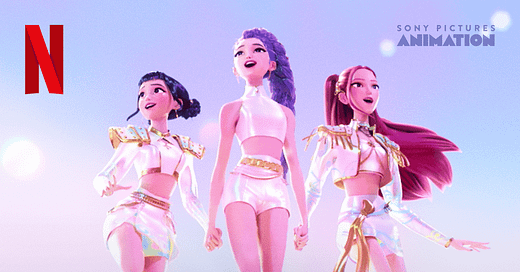



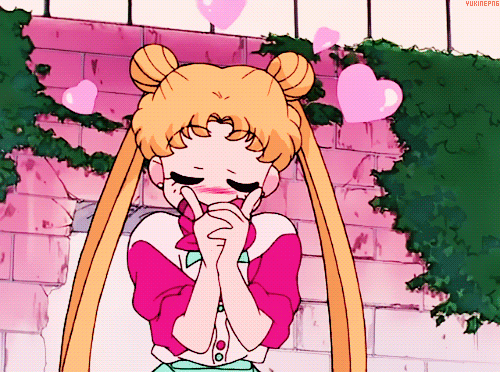

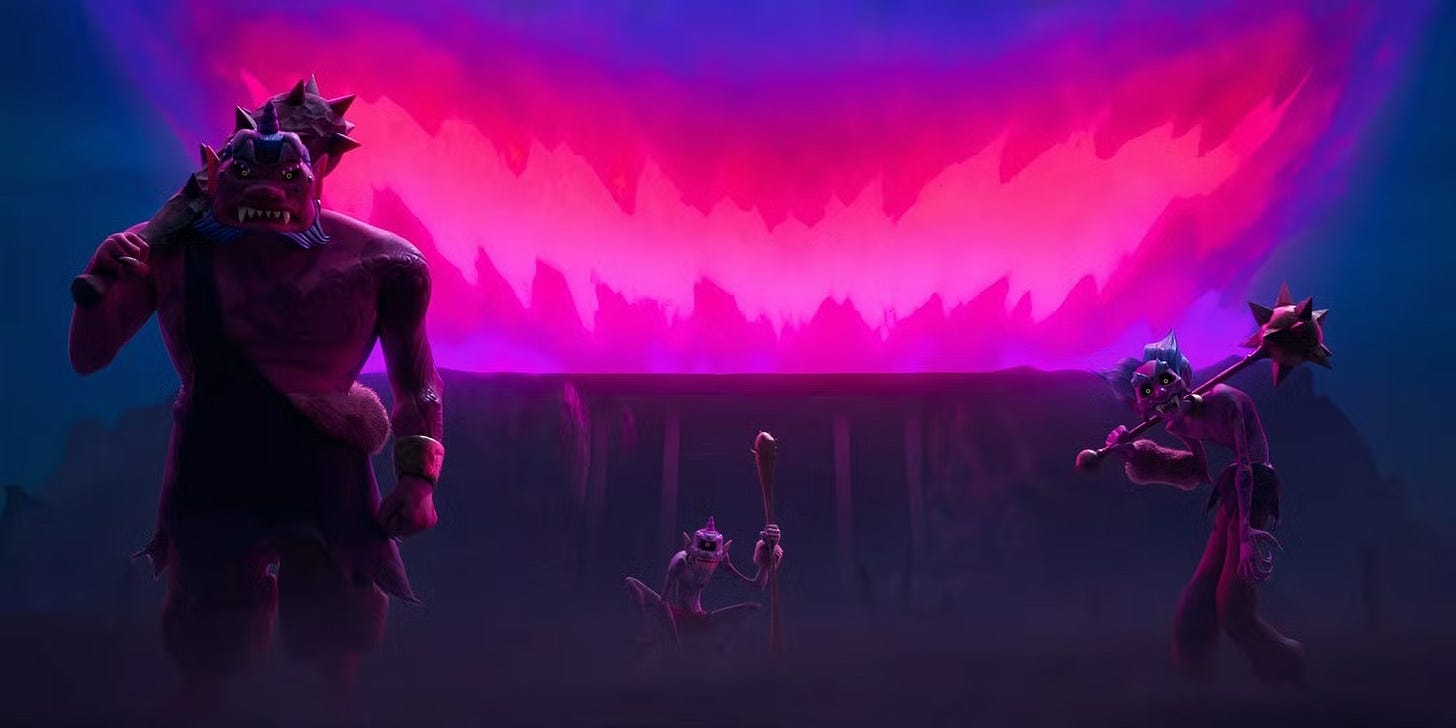
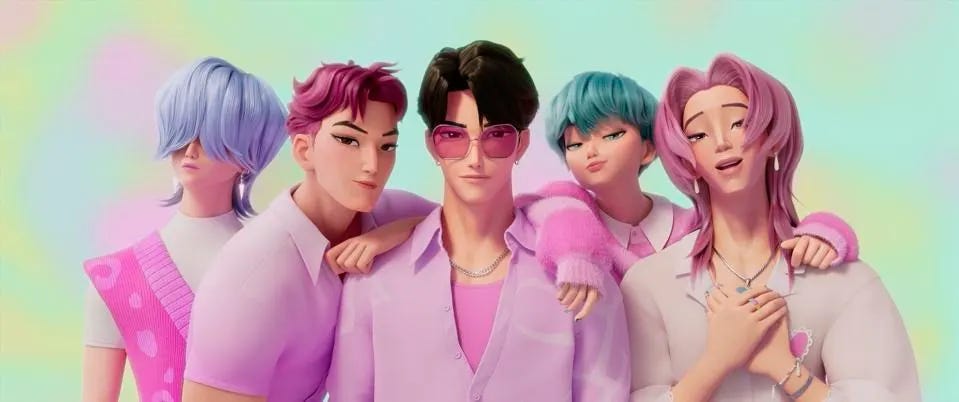
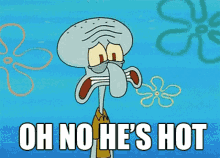
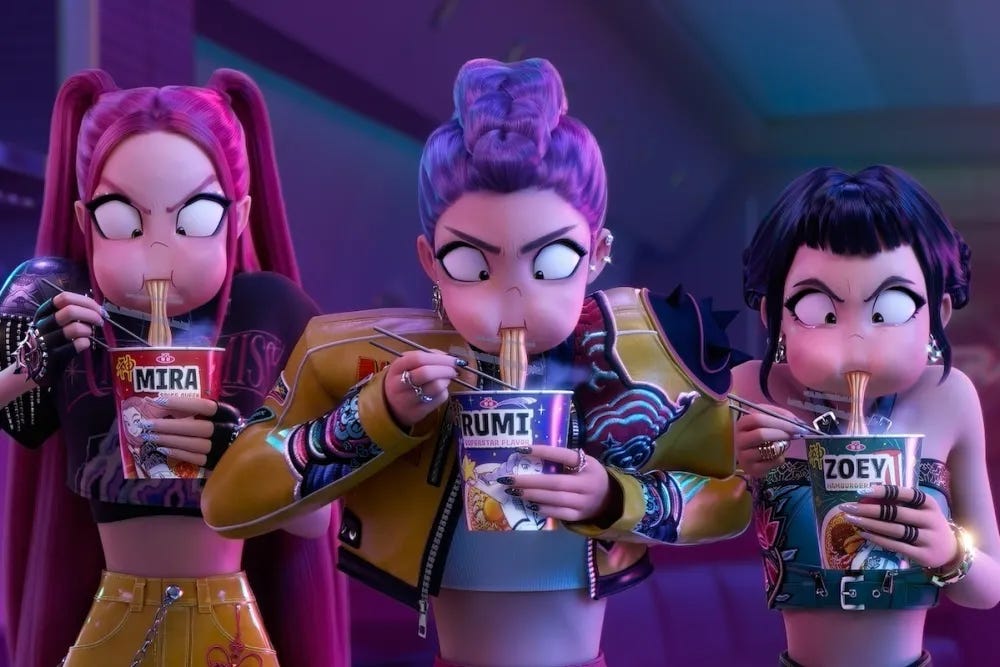
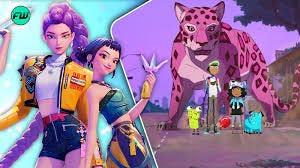
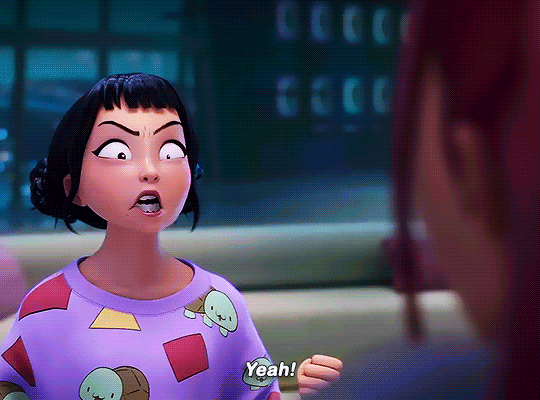
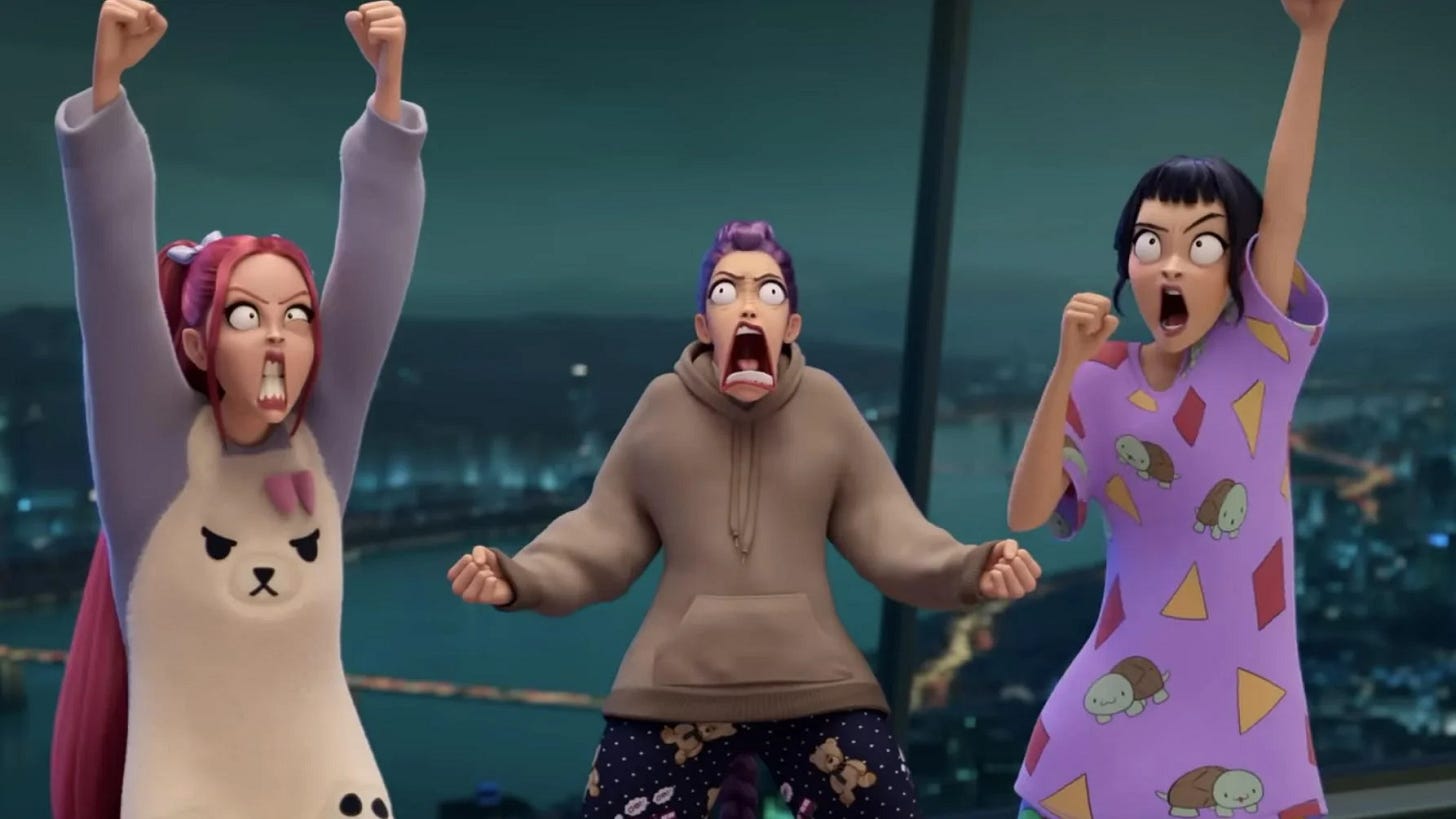

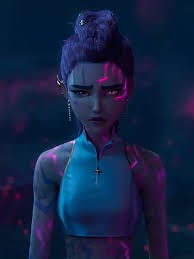


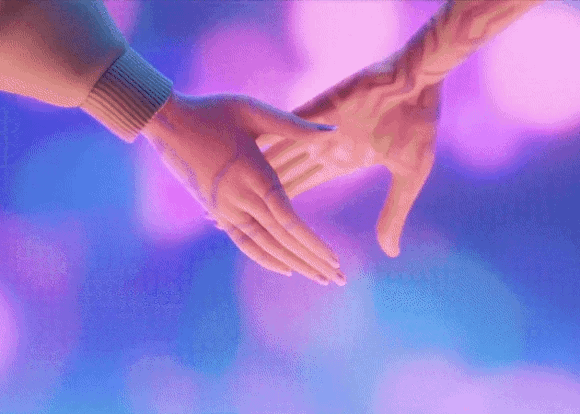


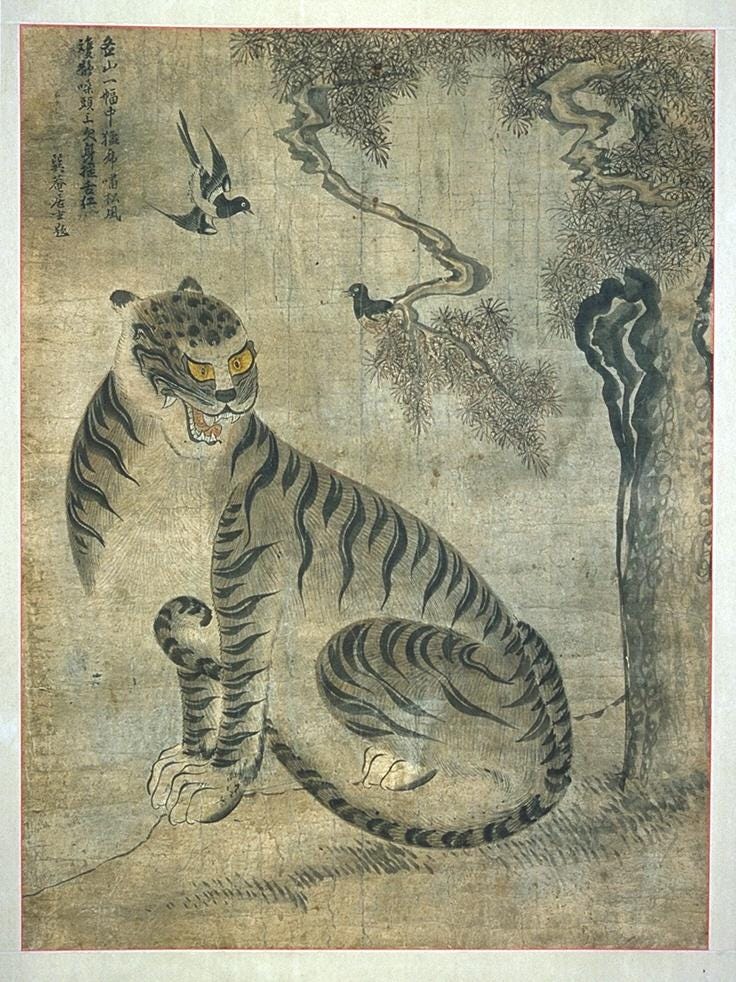




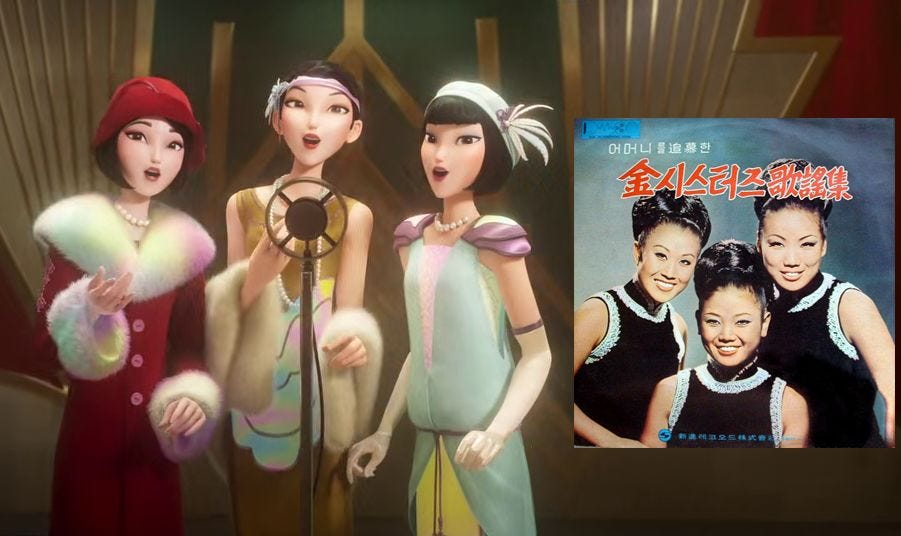

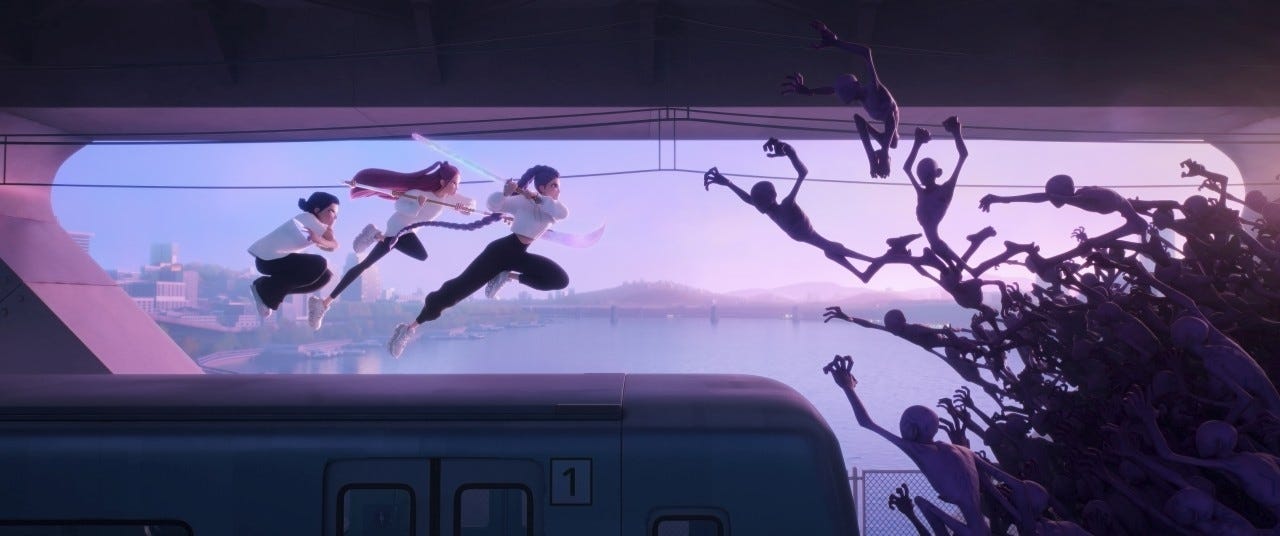
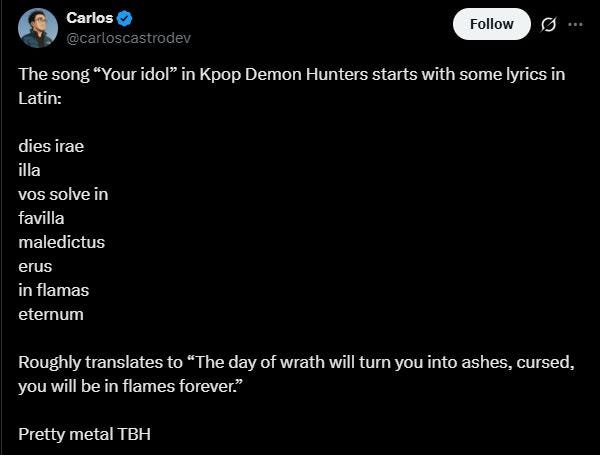


Your deep dive is delightful 😊 It's a wonderful movie, but there were a few things that let me down (and it's a shame because I truly feel it could have been perfect!!). If you don't mind me getting on my soap box a little, the main thing that ruined the fun for me was the exact thing you mentioned - the unclear distinction between demon and human-turned-demon. Also the unbelievably of Jinu being the only human-turned-demon if that's the case. It ruined the themes!
Here we have a story about accepting your true self and living proudly for Rumi, as a half demon. Then we have Jinu given the space to show he is more then a demon. Jinu is sympathetic and allowed to grow as a person. The demon woman in the verrryyy beginning airplane scene as well, seemed like she didn't really want to do these things and was being forced to.
Then the story does a hard pivot to "all demons evil" when Rumi questions if they are, then kills Jinu (which felt entirely unnecessary 😭), and all the demons are seemingly banished back to hell to suffer forever with Gwi-ma.
None of the other demons, not even the other saja boys, gets a chance to be anything other then evil or shown as lives worth saving as much as Jinu. Jinu cannot possibly be the only human who made mistakes they can earn forgiveness for. I just don't like a story about accepting your demon half ending in condemning all demons (and also not addressing the relationship between rumi's mother & demon father). I'd say, saving a good demon and showing rumi's demon father is the most important story beats this movie should have had.
Genuinely thought the ending would be Rumi "purifying" all the demons to release their souls from Gwi-ma's control and only trapping Gwi-ma down there in the end and giving Jinu another chance at a human life but also leaving room for franchising because the hongmoon still needs upkeep and Gwi-ma can still influence humans...instead it was the exact opposite. She broke down the hongmoon simply to erect it as the same thing it always was, a prison for demons.
And that's how a movie that could've been a 10/10 for me ended up as a 7/10 😔 (there's also issues with the romance but that's linked back to flaws in the theme too)